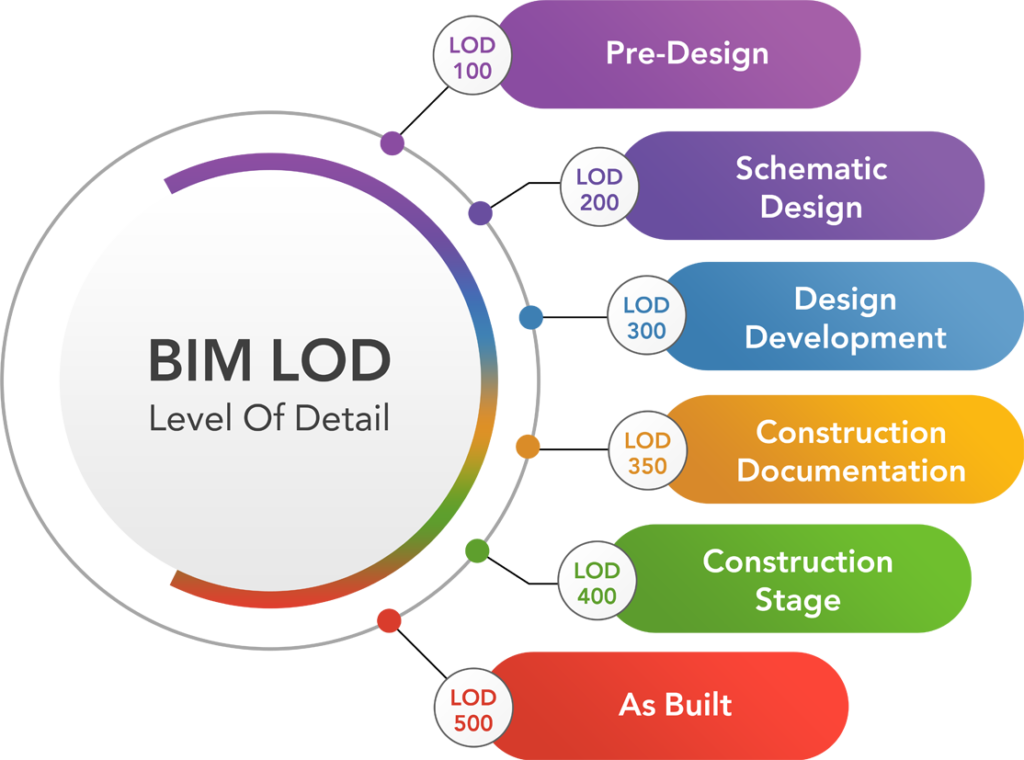In the world of Building Information Modeling (BIM), efficiency and accuracy are crucial for the success of architectural and construction projects. An essential piece of this puzzle is understanding Levels of Detail (LOD), a crucial concept that defines the extent and quality of information contained in BIM models at different stages of the process. In our new post, we will delve into the meaning and importance of Levels of Detail in BIM modeling, highlighting how this structured approach not only optimizes collaboration among various disciplines but also boosts operational efficiency and informed decision-making throughout the project’s lifecycle.
What are Levels of Detail (LOD)?
Levels of Detail, or LODs, are responsible for defining the degree of development and accuracy of modeled elements in different project phases, allowing a structured and progressive approach to the creation and use of these models. LODs range from 100 (low detail) to 500 (high detail), indicating the extent and quality of incorporated information.
At the project’s outset, a lower LOD may suffice for conceptual representations, while later stages may require higher LODs, incorporating specific construction details. This methodology not only facilitates efficient collaboration among project participants but also enhances communication and understanding of the building’s characteristics.

In this context, each level of detail is not just a measure of complexity but also a strategic tool guiding professionals throughout the project lifecycle, adapting to the specific needs of each phase and ensuring precise and efficient delivery at every stage. Let’s now deepen our understanding by exploring in detail the distinctive characteristics of each LOD and its influence on the excellence of BIM modeling.
LOD 100
Level of Detail (LOD) 100 represents the initial phase of the process, characterized by conceptual and simplified representations of project elements. In LOD 100, the emphasis is on creating models that capture the essence and overall configuration of the building or infrastructure without delving into specific construction details.
This level is often used in the early stages of the project, where the priority is to establish a basic understanding of the form and layout of the built environment. LOD 100 models are ideal for visual communication, collaboration among stakeholders, and conceptual decision-making.
LOD 100, therefore, serves as the foundation upon which detailed information will be built in subsequent phases of the project lifecycle.
LOD 200
Level of Detail (LOD) 200 represents an advancement from LOD 100, incorporating greater detailing and specific information into the three-dimensional model. In LOD 200, the focus is on including more precise elements and defining relationships between them. This level is often applied in intermediate project phases, where conceptual decisions have already been established, and it is now necessary to add more complexity to the model to reflect more detailed aspects of construction.
In LOD 200, objects are represented with more precise dimensions, and elements such as walls, doors, and windows begin to take on specific shapes. The geometry is more detailed, allowing for a better understanding of spatial relationships between different components. This level is valuable for in-depth analysis, preliminary cost estimates, and coordination between disciplines.
In summary, LOD 200 represents a step forward in the evolution of the BIM model, offering a more refined and detailed representation of elements, contributing to more informed decision-making in the intermediate phases of the project.
LOD 300
Level of Detail (LOD) 300 is a stage that stands out for incorporating more specific and detailed construction information into the three-dimensional model. In LOD 300, the focus is to deepen the understanding of the geometry, location, and characteristics of construction elements, providing a more precise and complete representation of building or infrastructure components.
This level is particularly relevant during the project development phases when a deeper knowledge is required for construction execution. Elements such as connection details, exact dimensions, and material specifications begin to be incorporated. LOD 300 is crucial for coordination between involved disciplines, contributing to early conflict detection and project optimization.
LOD 400
Level of Detail (LOD) 400 represents an advanced stage in which the three-dimensional model incorporates even more detailed and specific information, primarily geared towards the construction and manufacturing phase. In LOD 400, BIM model elements are enriched with more precise data about materials, specifications, and construction methods. This includes details such as exact dimensions, tolerances, and information specific to manufacturing.
This level is crucial for construction and manufacturing teams, allowing for a detailed analysis of project conditions and facilitating efficient coordination between different disciplines. LOD 400 is also valuable for creating construction documentation, construction planning, and construction simulation, contributing to the effective execution of the project.
In summary, LOD 400 takes Building Information Modeling to a more refined level, providing detailed data necessary for precise construction and manufacturing.
LOD 500
Level of Detail (LOD) 500 is the most advanced and comprehensive level on the LOD scale. It focuses on operational and maintenance information for the building or infrastructure, being especially relevant for later stages of the project lifecycle, such as asset management and operation of the built facility.
In LOD 500, the BIM model includes extremely specific details about the physical characteristics of elements, including information related to maintenance, replacement, and performance over time. This level is valuable for owners and facility managers as it provides essential data for decision-making throughout the building’s lifespan.
In summary, LOD 500 extends the application of BIM beyond the construction phases, providing detailed and up-to-date information that contributes to effective management of built assets over time.

Navigating the Path of LODs in BIM: What are the Popular Software in Construction?
As we delve into the intricate journey of Levels of Detail (LOD) in Building Information Modeling (BIM), we discover how this methodology provides a structured evolution in the digital representation of projects. From conceptual early stages to crucial operational details, LODs play a vital role in each phase of the project lifecycle. Now that we understand the importance of LODs, we will deepen our knowledge by exploring Popular BIM Software in the Construction Industry in our next post. By understanding how these tools contribute to the effective implementation of LODs, we provide beginners with an insight into the BIM ecosystem, empowering them to delve further into the complexities and opportunities that Building Information Modeling offers.




Deixe um comentário